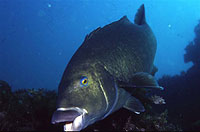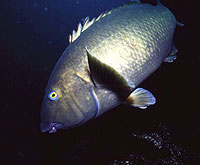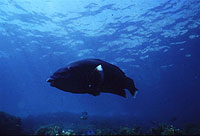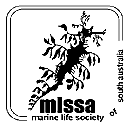Western Blue Groper
Major Source: Marine Life Society of South Australia Inc
Although there is a closure to Western Blue Groper fishing in S.A. Gulfs and Investigator Strait waters, and the species is also protected in a number of small Aquatic Reserves, it appears that this is insufficient as a means of protecting Western Blue Groper in South Australia, because:
- the species does not occur in the upper and most of the central parts of either gulf due to lack of suitable habitat and oceanographic conditions, and therefore only a small part of the species range in S.A. is formally protected;
- some fishers appear not to adhere to the prohibition of fishing for Western Blue Groper in Investigator Strait, or offshore reefs and islands within the closed area, the southern boundary of which spans from western Kangaroo Island to southern Eyre, and illegal catches appear not to be monitored;
- there has been increased targeting of this species in offshore areas during the past decade, particularly by charter boats operating off the central and western coasts of S.A.; and
- some reef fishers do not recognise juvenile Western blue gropers when they are caught as bycatch, and small specimens are thus retained for use as bait.
|

Getting up close and personal with
a Western Blue Groper |
Actions needed to overcome the identified threats include:
- Legislative protection - there is a clear need for the extension of the current protection for these fish. This could include listing as endangered under the EPBC Act (1999) and the National Parks and Wildlife Act as well as extension of current protection under the Fisheries Act to cover all State waters.
- The size limit on Western Blue Groper be abolished so all caught fish must be returned to the sea.
- The catching and photographing of “trophy” fish be banned, as the fish is exposed to the air for unacceptable amounts of time and their protective slime coating would be damaged by this increased handling.
- Increased and maintained research and monitoring for the species such as the Reef Watch ‘Feral or in Peril’ programme. (Western Blue Groper are currently one of the ‘in peril’ species targeted by this programme).
- Reduction and mitigation of human impacts on the marine environment and reef habitat in particular, i.e. sedimentation, excess nutrient inputs and other pollution.
- Actions and education to encourage compliance with current size and catch limits, in particular the issue of non or misidentification of juveniles by anglers needs to be addressed.
- Actions to avoid and reduce bycatch of this species. For example pot and trap designs that reduce the bycatch of fish should be encouraged
- The use of Western Blue Groper as cray pot bait should be prohibited by regulation under the Fisheries Management Act (2007).
- A number of Western Blue Groper ‘hotspots’ for both adult and juvenile fish have already been identified and these need to be protected in marine park sanctuary zones. Marine parks in conjunction with improved marine planning can also help address climate change impacts.
|

A female Western Blue Groper

Western Blue Groper
|
Thanks
| Our thanks to the Marine Life Society of South Australia Inc and to Phillip Hall for allowing us to reproduce their materials on the Western Blue Groper from their Current Issues page of their website. Also many thanks to
David Muirhead for images of the Western Blue Groper. |
 |
|
|





